DCS Group Talent Management: A Unit 6 Business Project Report
VerifiedAdded on 2023/06/14
|22
|3986
|274
Report
AI Summary
This report examines the impact of different cultures on talent management approaches within DCS Group, a distributor of health, beauty, and household products. The project aims to identify how cultural differences influence talent management strategies, focusing on the significance of cultural diversity, its impact on DCS Group's talent management, and the development of effective approaches to maintain cultural inclusion. The report includes a project management plan, a work breakdown structure with a Gantt chart, and applies both qualitative and quantitative research methods, including a questionnaire distributed to 20 DCS Group employees. Data analysis reveals insights into employees' understanding of diversity and inclusion, strategies for minimizing cultural differences, barriers faced by managers, and the influence of culture on talent management approaches. The report concludes with recommendations for DCS Group, including cross-sectional training to improve cultural knowledge and enhance diversity and inclusion within the workplace. Desklib offers this and many other solved assignments to help students.
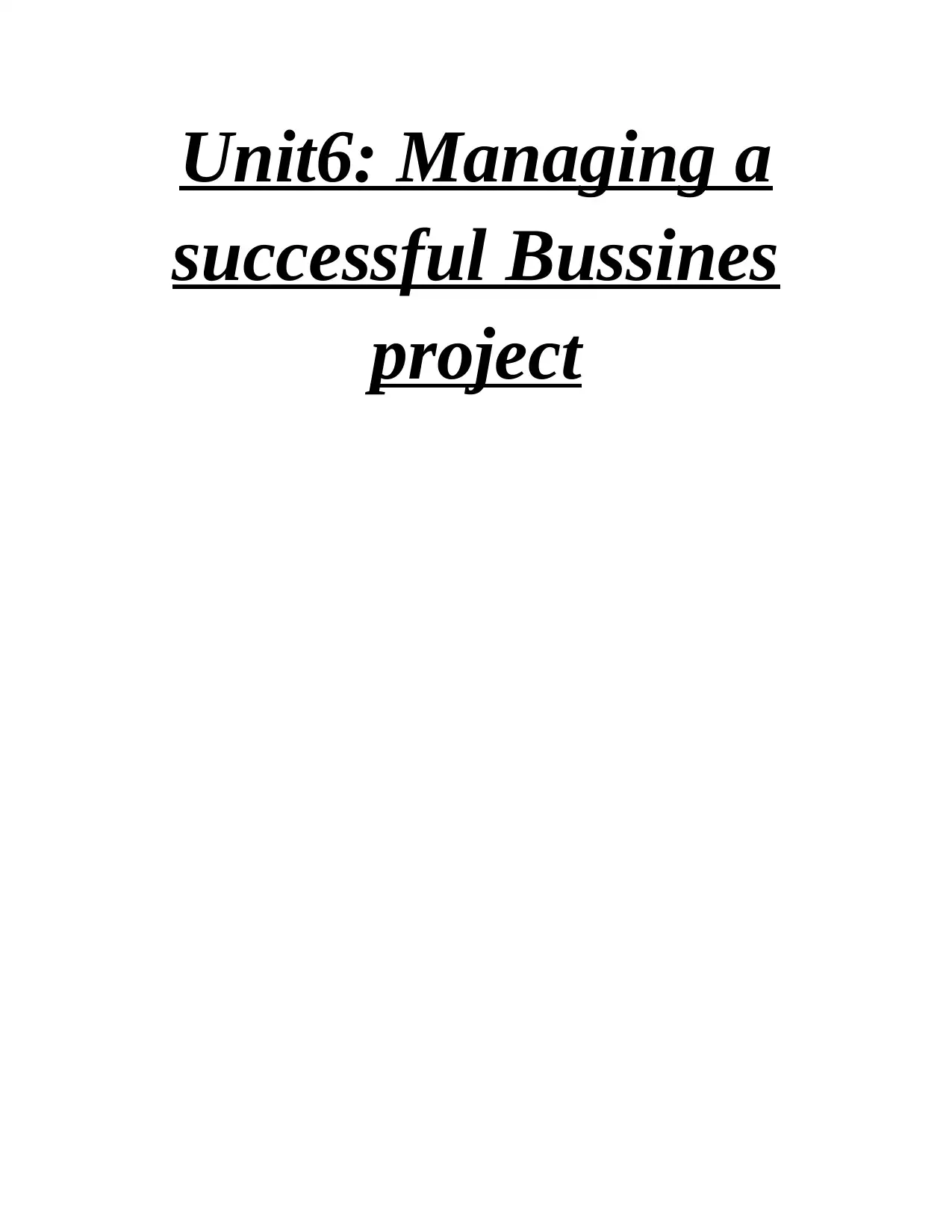
Unit6: Managing a
successful Bussines
project
successful Bussines
project
Paraphrase This Document
Need a fresh take? Get an instant paraphrase of this document with our AI Paraphraser
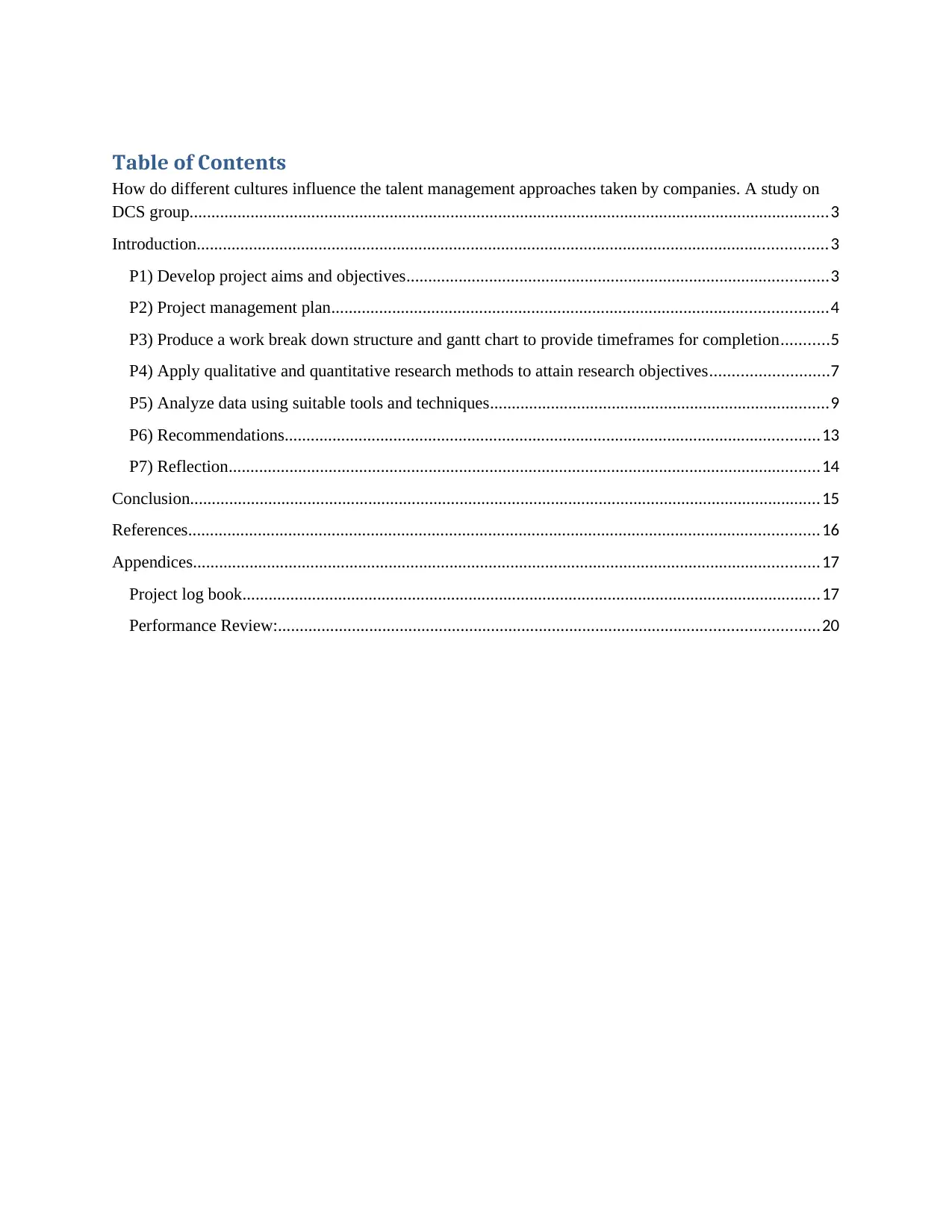
Table of Contents
How do different cultures influence the talent management approaches taken by companies. A study on
DCS group...................................................................................................................................................3
Introduction.................................................................................................................................................3
P1) Develop project aims and objectives.................................................................................................3
P2) Project management plan..................................................................................................................4
P3) Produce a work break down structure and gantt chart to provide timeframes for completion...........5
P4) Apply qualitative and quantitative research methods to attain research objectives...........................7
P5) Analyze data using suitable tools and techniques..............................................................................9
P6) Recommendations...........................................................................................................................13
P7) Reflection........................................................................................................................................14
Conclusion.................................................................................................................................................15
References.................................................................................................................................................16
Appendices................................................................................................................................................17
Project log book.....................................................................................................................................17
Performance Review:............................................................................................................................20
How do different cultures influence the talent management approaches taken by companies. A study on
DCS group...................................................................................................................................................3
Introduction.................................................................................................................................................3
P1) Develop project aims and objectives.................................................................................................3
P2) Project management plan..................................................................................................................4
P3) Produce a work break down structure and gantt chart to provide timeframes for completion...........5
P4) Apply qualitative and quantitative research methods to attain research objectives...........................7
P5) Analyze data using suitable tools and techniques..............................................................................9
P6) Recommendations...........................................................................................................................13
P7) Reflection........................................................................................................................................14
Conclusion.................................................................................................................................................15
References.................................................................................................................................................16
Appendices................................................................................................................................................17
Project log book.....................................................................................................................................17
Performance Review:............................................................................................................................20
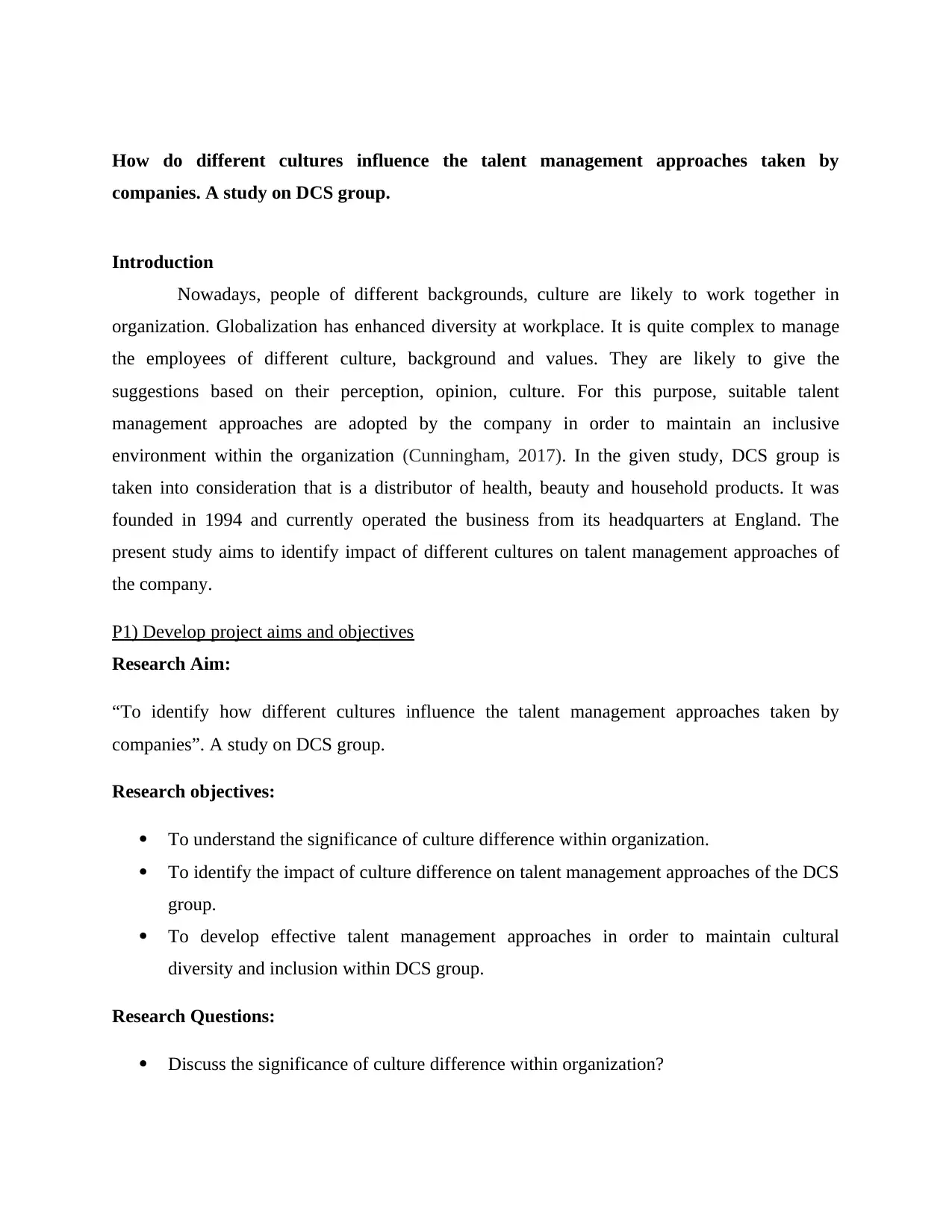
How do different cultures influence the talent management approaches taken by
companies. A study on DCS group.
Introduction
Nowadays, people of different backgrounds, culture are likely to work together in
organization. Globalization has enhanced diversity at workplace. It is quite complex to manage
the employees of different culture, background and values. They are likely to give the
suggestions based on their perception, opinion, culture. For this purpose, suitable talent
management approaches are adopted by the company in order to maintain an inclusive
environment within the organization (Cunningham, 2017). In the given study, DCS group is
taken into consideration that is a distributor of health, beauty and household products. It was
founded in 1994 and currently operated the business from its headquarters at England. The
present study aims to identify impact of different cultures on talent management approaches of
the company.
P1) Develop project aims and objectives
Research Aim:
“To identify how different cultures influence the talent management approaches taken by
companies”. A study on DCS group.
Research objectives:
To understand the significance of culture difference within organization.
To identify the impact of culture difference on talent management approaches of the DCS
group.
To develop effective talent management approaches in order to maintain cultural
diversity and inclusion within DCS group.
Research Questions:
Discuss the significance of culture difference within organization?
companies. A study on DCS group.
Introduction
Nowadays, people of different backgrounds, culture are likely to work together in
organization. Globalization has enhanced diversity at workplace. It is quite complex to manage
the employees of different culture, background and values. They are likely to give the
suggestions based on their perception, opinion, culture. For this purpose, suitable talent
management approaches are adopted by the company in order to maintain an inclusive
environment within the organization (Cunningham, 2017). In the given study, DCS group is
taken into consideration that is a distributor of health, beauty and household products. It was
founded in 1994 and currently operated the business from its headquarters at England. The
present study aims to identify impact of different cultures on talent management approaches of
the company.
P1) Develop project aims and objectives
Research Aim:
“To identify how different cultures influence the talent management approaches taken by
companies”. A study on DCS group.
Research objectives:
To understand the significance of culture difference within organization.
To identify the impact of culture difference on talent management approaches of the DCS
group.
To develop effective talent management approaches in order to maintain cultural
diversity and inclusion within DCS group.
Research Questions:
Discuss the significance of culture difference within organization?
⊘ This is a preview!⊘
Do you want full access?
Subscribe today to unlock all pages.

Trusted by 1+ million students worldwide
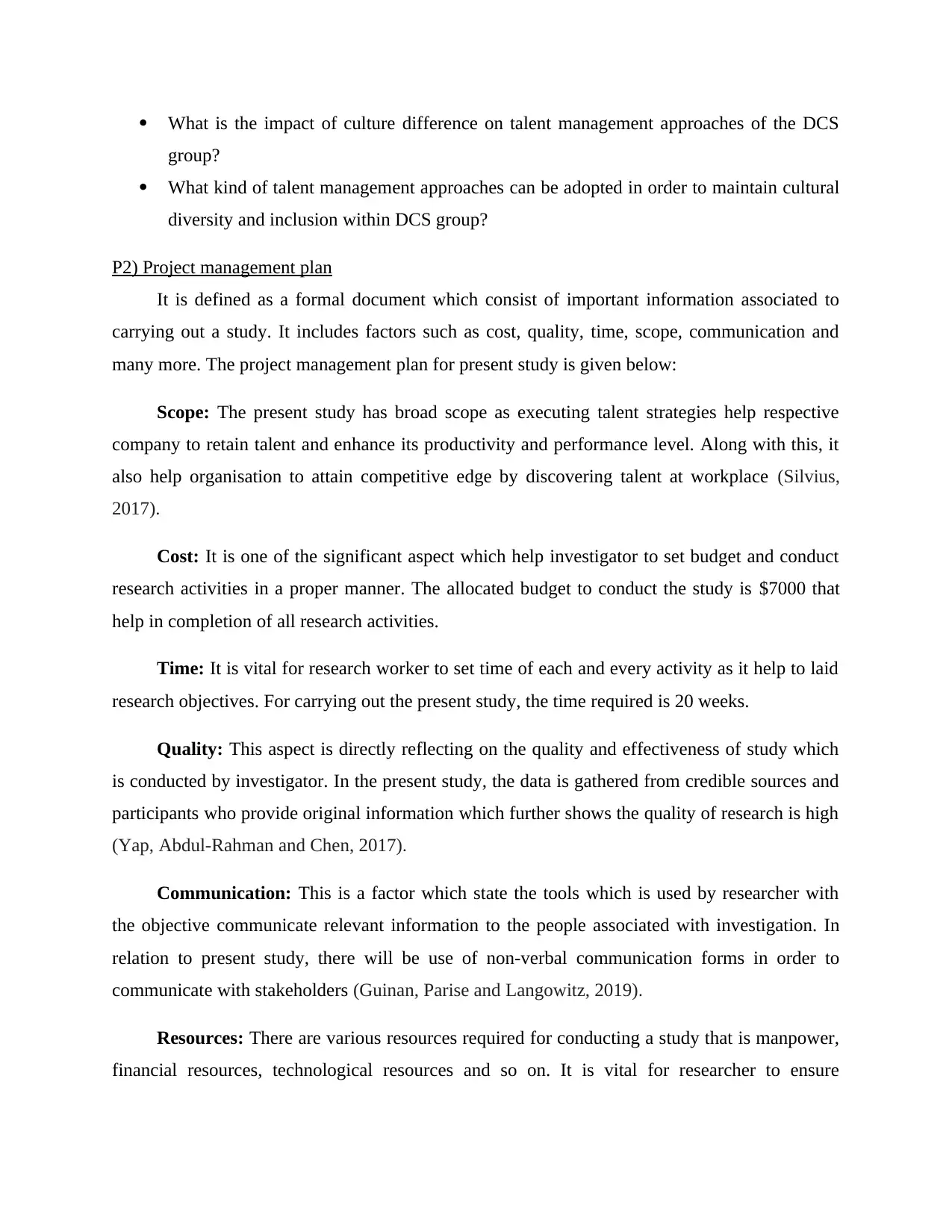
What is the impact of culture difference on talent management approaches of the DCS
group?
What kind of talent management approaches can be adopted in order to maintain cultural
diversity and inclusion within DCS group?
P2) Project management plan
It is defined as a formal document which consist of important information associated to
carrying out a study. It includes factors such as cost, quality, time, scope, communication and
many more. The project management plan for present study is given below:
Scope: The present study has broad scope as executing talent strategies help respective
company to retain talent and enhance its productivity and performance level. Along with this, it
also help organisation to attain competitive edge by discovering talent at workplace (Silvius,
2017).
Cost: It is one of the significant aspect which help investigator to set budget and conduct
research activities in a proper manner. The allocated budget to conduct the study is $7000 that
help in completion of all research activities.
Time: It is vital for research worker to set time of each and every activity as it help to laid
research objectives. For carrying out the present study, the time required is 20 weeks.
Quality: This aspect is directly reflecting on the quality and effectiveness of study which
is conducted by investigator. In the present study, the data is gathered from credible sources and
participants who provide original information which further shows the quality of research is high
(Yap, Abdul-Rahman and Chen, 2017).
Communication: This is a factor which state the tools which is used by researcher with
the objective communicate relevant information to the people associated with investigation. In
relation to present study, there will be use of non-verbal communication forms in order to
communicate with stakeholders (Guinan, Parise and Langowitz, 2019).
Resources: There are various resources required for conducting a study that is manpower,
financial resources, technological resources and so on. It is vital for researcher to ensure
group?
What kind of talent management approaches can be adopted in order to maintain cultural
diversity and inclusion within DCS group?
P2) Project management plan
It is defined as a formal document which consist of important information associated to
carrying out a study. It includes factors such as cost, quality, time, scope, communication and
many more. The project management plan for present study is given below:
Scope: The present study has broad scope as executing talent strategies help respective
company to retain talent and enhance its productivity and performance level. Along with this, it
also help organisation to attain competitive edge by discovering talent at workplace (Silvius,
2017).
Cost: It is one of the significant aspect which help investigator to set budget and conduct
research activities in a proper manner. The allocated budget to conduct the study is $7000 that
help in completion of all research activities.
Time: It is vital for research worker to set time of each and every activity as it help to laid
research objectives. For carrying out the present study, the time required is 20 weeks.
Quality: This aspect is directly reflecting on the quality and effectiveness of study which
is conducted by investigator. In the present study, the data is gathered from credible sources and
participants who provide original information which further shows the quality of research is high
(Yap, Abdul-Rahman and Chen, 2017).
Communication: This is a factor which state the tools which is used by researcher with
the objective communicate relevant information to the people associated with investigation. In
relation to present study, there will be use of non-verbal communication forms in order to
communicate with stakeholders (Guinan, Parise and Langowitz, 2019).
Resources: There are various resources required for conducting a study that is manpower,
financial resources, technological resources and so on. It is vital for researcher to ensure
Paraphrase This Document
Need a fresh take? Get an instant paraphrase of this document with our AI Paraphraser
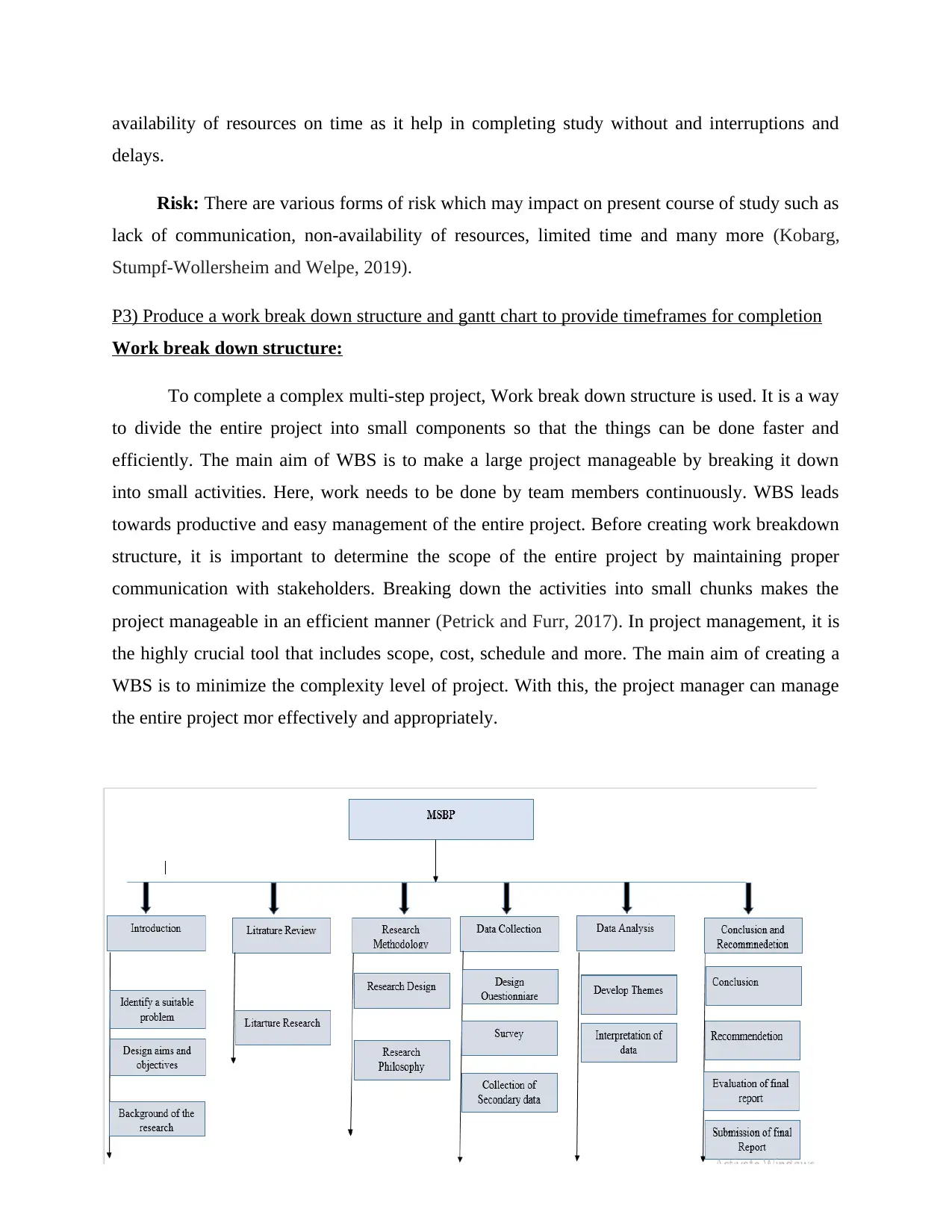
availability of resources on time as it help in completing study without and interruptions and
delays.
Risk: There are various forms of risk which may impact on present course of study such as
lack of communication, non-availability of resources, limited time and many more (Kobarg,
Stumpf-Wollersheim and Welpe, 2019).
P3) Produce a work break down structure and gantt chart to provide timeframes for completion
Work break down structure:
To complete a complex multi-step project, Work break down structure is used. It is a way
to divide the entire project into small components so that the things can be done faster and
efficiently. The main aim of WBS is to make a large project manageable by breaking it down
into small activities. Here, work needs to be done by team members continuously. WBS leads
towards productive and easy management of the entire project. Before creating work breakdown
structure, it is important to determine the scope of the entire project by maintaining proper
communication with stakeholders. Breaking down the activities into small chunks makes the
project manageable in an efficient manner (Petrick and Furr, 2017). In project management, it is
the highly crucial tool that includes scope, cost, schedule and more. The main aim of creating a
WBS is to minimize the complexity level of project. With this, the project manager can manage
the entire project mor effectively and appropriately.
delays.
Risk: There are various forms of risk which may impact on present course of study such as
lack of communication, non-availability of resources, limited time and many more (Kobarg,
Stumpf-Wollersheim and Welpe, 2019).
P3) Produce a work break down structure and gantt chart to provide timeframes for completion
Work break down structure:
To complete a complex multi-step project, Work break down structure is used. It is a way
to divide the entire project into small components so that the things can be done faster and
efficiently. The main aim of WBS is to make a large project manageable by breaking it down
into small activities. Here, work needs to be done by team members continuously. WBS leads
towards productive and easy management of the entire project. Before creating work breakdown
structure, it is important to determine the scope of the entire project by maintaining proper
communication with stakeholders. Breaking down the activities into small chunks makes the
project manageable in an efficient manner (Petrick and Furr, 2017). In project management, it is
the highly crucial tool that includes scope, cost, schedule and more. The main aim of creating a
WBS is to minimize the complexity level of project. With this, the project manager can manage
the entire project mor effectively and appropriately.
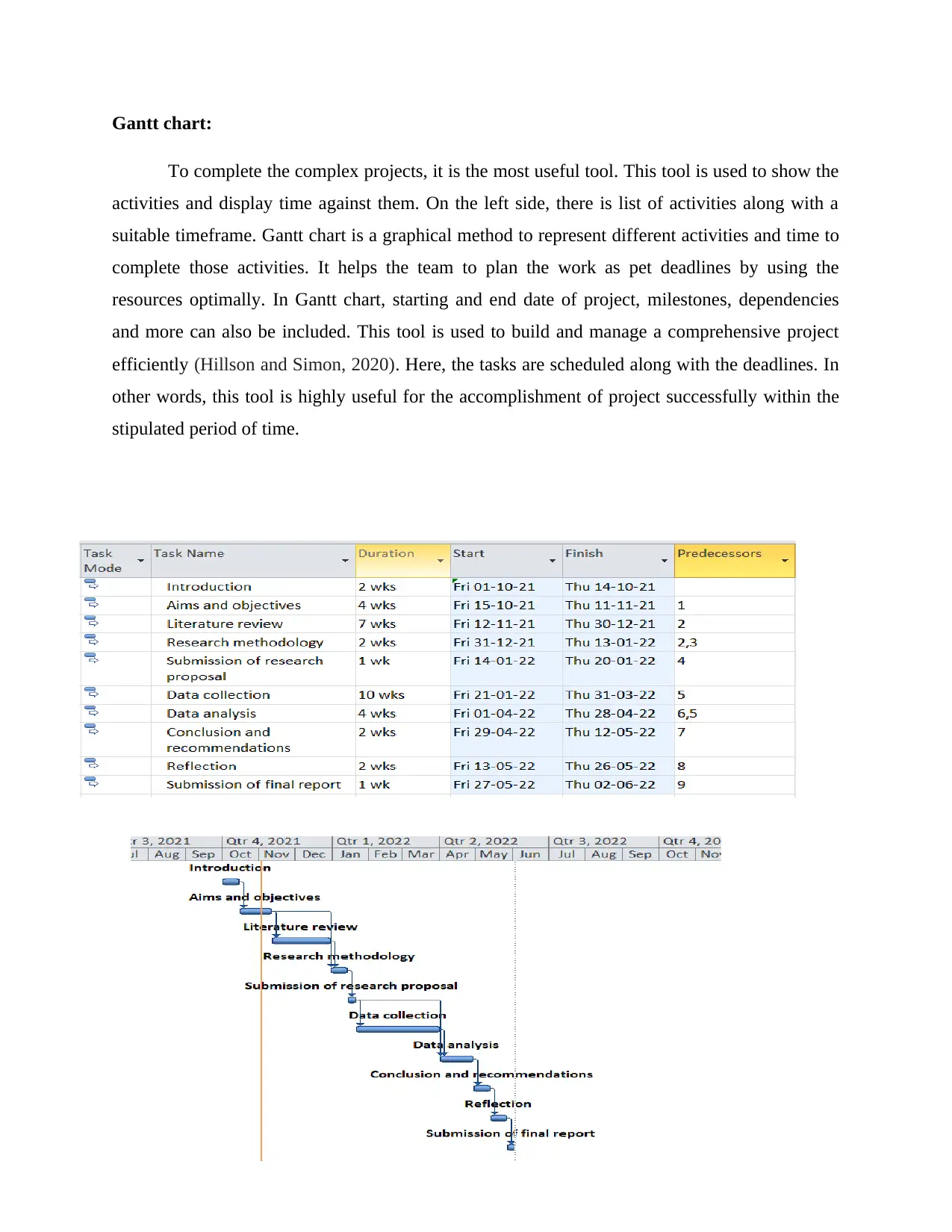
Gantt chart:
To complete the complex projects, it is the most useful tool. This tool is used to show the
activities and display time against them. On the left side, there is list of activities along with a
suitable timeframe. Gantt chart is a graphical method to represent different activities and time to
complete those activities. It helps the team to plan the work as pet deadlines by using the
resources optimally. In Gantt chart, starting and end date of project, milestones, dependencies
and more can also be included. This tool is used to build and manage a comprehensive project
efficiently (Hillson and Simon, 2020). Here, the tasks are scheduled along with the deadlines. In
other words, this tool is highly useful for the accomplishment of project successfully within the
stipulated period of time.
To complete the complex projects, it is the most useful tool. This tool is used to show the
activities and display time against them. On the left side, there is list of activities along with a
suitable timeframe. Gantt chart is a graphical method to represent different activities and time to
complete those activities. It helps the team to plan the work as pet deadlines by using the
resources optimally. In Gantt chart, starting and end date of project, milestones, dependencies
and more can also be included. This tool is used to build and manage a comprehensive project
efficiently (Hillson and Simon, 2020). Here, the tasks are scheduled along with the deadlines. In
other words, this tool is highly useful for the accomplishment of project successfully within the
stipulated period of time.
⊘ This is a preview!⊘
Do you want full access?
Subscribe today to unlock all pages.

Trusted by 1+ million students worldwide
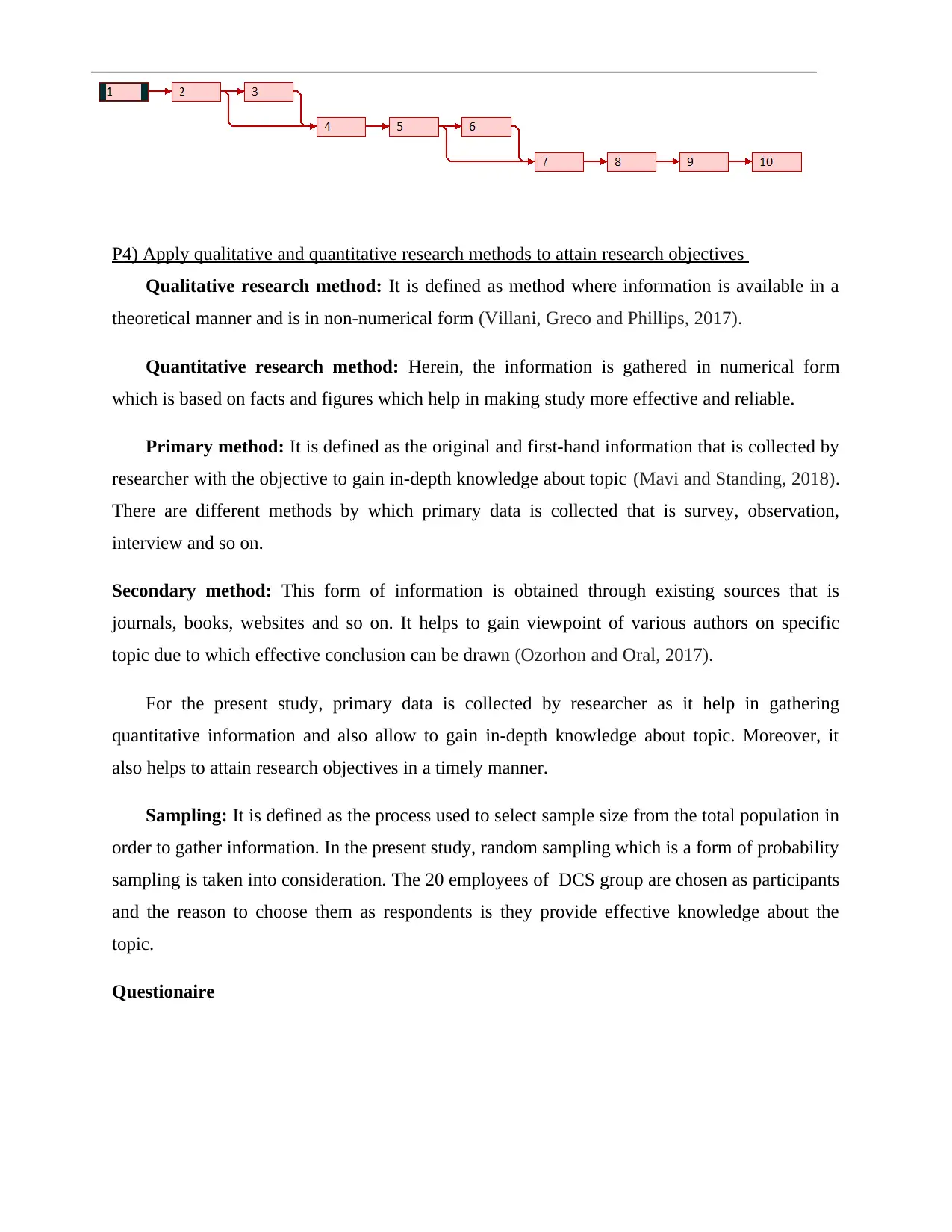
P4) Apply qualitative and quantitative research methods to attain research objectives
Qualitative research method: It is defined as method where information is available in a
theoretical manner and is in non-numerical form (Villani, Greco and Phillips, 2017).
Quantitative research method: Herein, the information is gathered in numerical form
which is based on facts and figures which help in making study more effective and reliable.
Primary method: It is defined as the original and first-hand information that is collected by
researcher with the objective to gain in-depth knowledge about topic (Mavi and Standing, 2018).
There are different methods by which primary data is collected that is survey, observation,
interview and so on.
Secondary method: This form of information is obtained through existing sources that is
journals, books, websites and so on. It helps to gain viewpoint of various authors on specific
topic due to which effective conclusion can be drawn (Ozorhon and Oral, 2017).
For the present study, primary data is collected by researcher as it help in gathering
quantitative information and also allow to gain in-depth knowledge about topic. Moreover, it
also helps to attain research objectives in a timely manner.
Sampling: It is defined as the process used to select sample size from the total population in
order to gather information. In the present study, random sampling which is a form of probability
sampling is taken into consideration. The 20 employees of DCS group are chosen as participants
and the reason to choose them as respondents is they provide effective knowledge about the
topic.
Questionaire
Qualitative research method: It is defined as method where information is available in a
theoretical manner and is in non-numerical form (Villani, Greco and Phillips, 2017).
Quantitative research method: Herein, the information is gathered in numerical form
which is based on facts and figures which help in making study more effective and reliable.
Primary method: It is defined as the original and first-hand information that is collected by
researcher with the objective to gain in-depth knowledge about topic (Mavi and Standing, 2018).
There are different methods by which primary data is collected that is survey, observation,
interview and so on.
Secondary method: This form of information is obtained through existing sources that is
journals, books, websites and so on. It helps to gain viewpoint of various authors on specific
topic due to which effective conclusion can be drawn (Ozorhon and Oral, 2017).
For the present study, primary data is collected by researcher as it help in gathering
quantitative information and also allow to gain in-depth knowledge about topic. Moreover, it
also helps to attain research objectives in a timely manner.
Sampling: It is defined as the process used to select sample size from the total population in
order to gather information. In the present study, random sampling which is a form of probability
sampling is taken into consideration. The 20 employees of DCS group are chosen as participants
and the reason to choose them as respondents is they provide effective knowledge about the
topic.
Questionaire
Paraphrase This Document
Need a fresh take? Get an instant paraphrase of this document with our AI Paraphraser
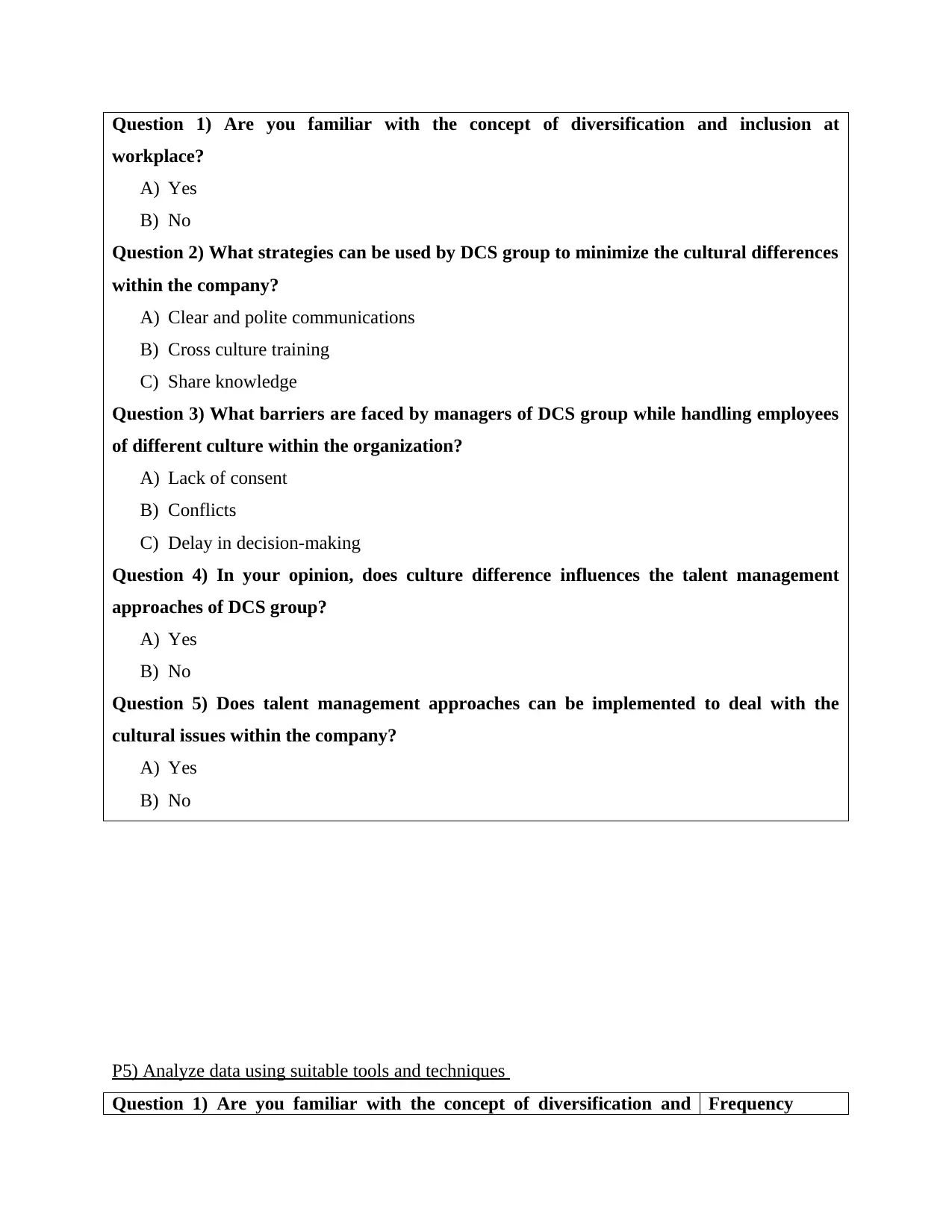
Question 1) Are you familiar with the concept of diversification and inclusion at
workplace?
A) Yes
B) No
Question 2) What strategies can be used by DCS group to minimize the cultural differences
within the company?
A) Clear and polite communications
B) Cross culture training
C) Share knowledge
Question 3) What barriers are faced by managers of DCS group while handling employees
of different culture within the organization?
A) Lack of consent
B) Conflicts
C) Delay in decision-making
Question 4) In your opinion, does culture difference influences the talent management
approaches of DCS group?
A) Yes
B) No
Question 5) Does talent management approaches can be implemented to deal with the
cultural issues within the company?
A) Yes
B) No
P5) Analyze data using suitable tools and techniques
Question 1) Are you familiar with the concept of diversification and Frequency
workplace?
A) Yes
B) No
Question 2) What strategies can be used by DCS group to minimize the cultural differences
within the company?
A) Clear and polite communications
B) Cross culture training
C) Share knowledge
Question 3) What barriers are faced by managers of DCS group while handling employees
of different culture within the organization?
A) Lack of consent
B) Conflicts
C) Delay in decision-making
Question 4) In your opinion, does culture difference influences the talent management
approaches of DCS group?
A) Yes
B) No
Question 5) Does talent management approaches can be implemented to deal with the
cultural issues within the company?
A) Yes
B) No
P5) Analyze data using suitable tools and techniques
Question 1) Are you familiar with the concept of diversification and Frequency
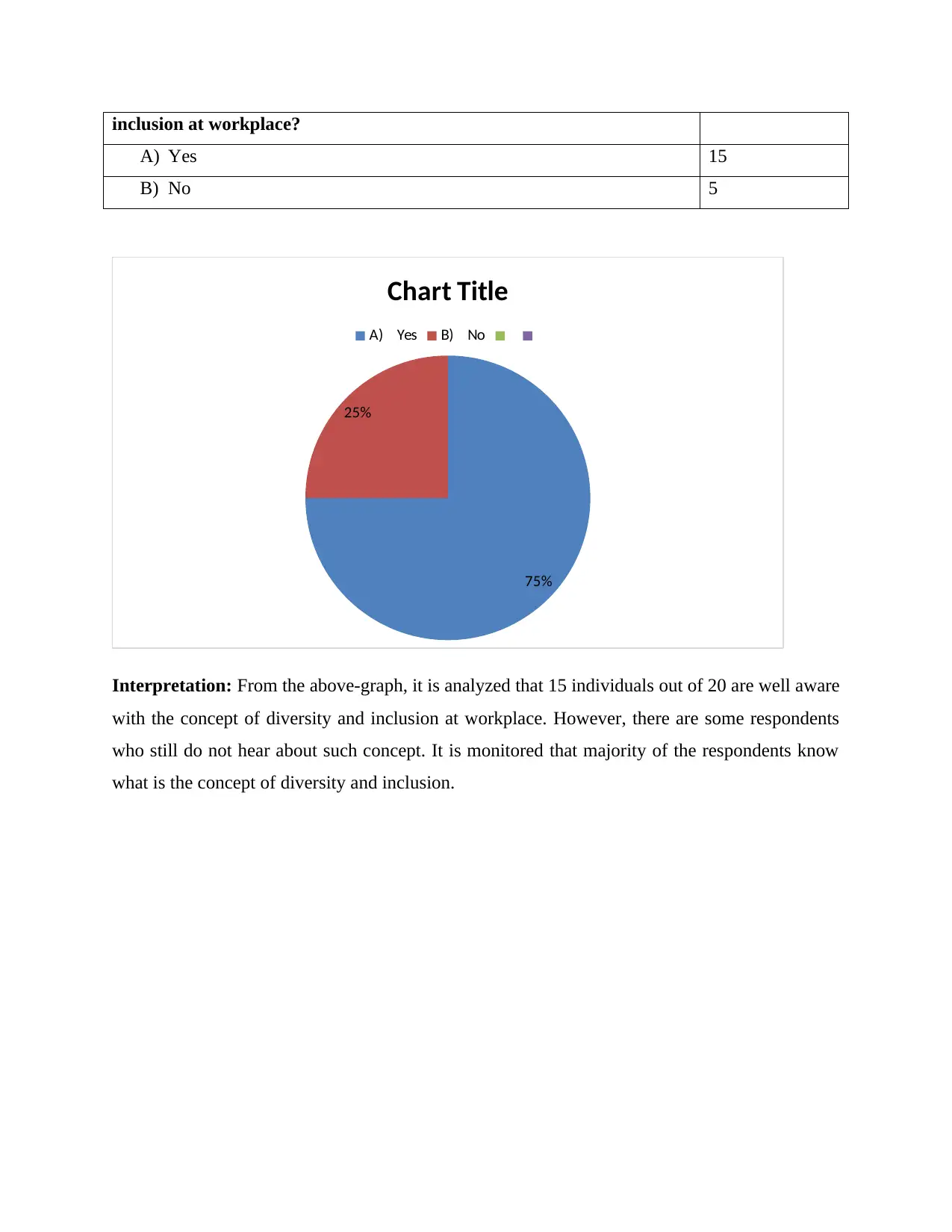
inclusion at workplace?
A) Yes 15
B) No 5
75%
25%
Chart Title
A) Yes B) No
Interpretation: From the above-graph, it is analyzed that 15 individuals out of 20 are well aware
with the concept of diversity and inclusion at workplace. However, there are some respondents
who still do not hear about such concept. It is monitored that majority of the respondents know
what is the concept of diversity and inclusion.
A) Yes 15
B) No 5
75%
25%
Chart Title
A) Yes B) No
Interpretation: From the above-graph, it is analyzed that 15 individuals out of 20 are well aware
with the concept of diversity and inclusion at workplace. However, there are some respondents
who still do not hear about such concept. It is monitored that majority of the respondents know
what is the concept of diversity and inclusion.
⊘ This is a preview!⊘
Do you want full access?
Subscribe today to unlock all pages.

Trusted by 1+ million students worldwide
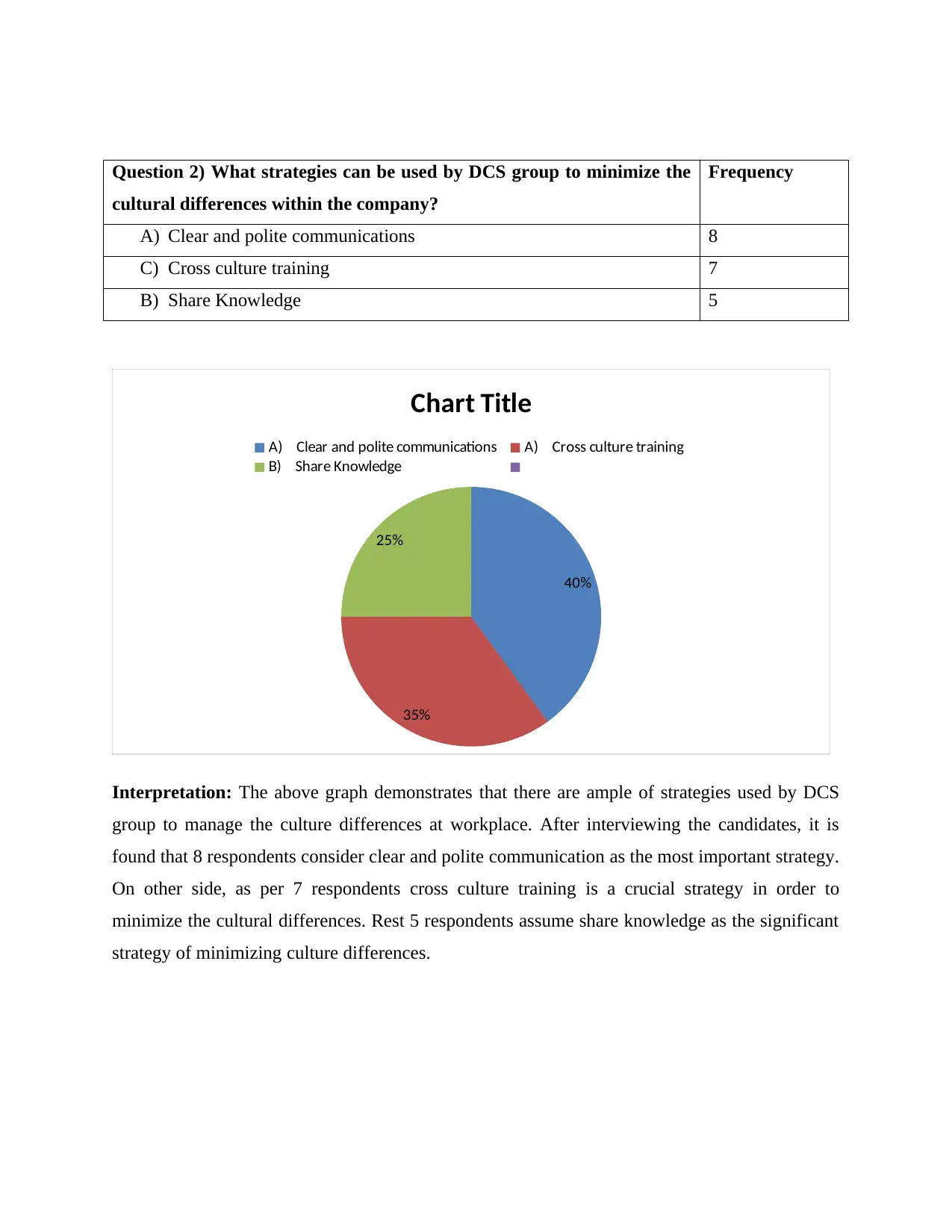
Question 2) What strategies can be used by DCS group to minimize the
cultural differences within the company?
Frequency
A) Clear and polite communications 8
C) Cross culture training 7
B) Share Knowledge 5
40%
35%
25%
Chart Title
A) Clear and polite communications A) Cross culture training
B) Share Knowledge
Interpretation: The above graph demonstrates that there are ample of strategies used by DCS
group to manage the culture differences at workplace. After interviewing the candidates, it is
found that 8 respondents consider clear and polite communication as the most important strategy.
On other side, as per 7 respondents cross culture training is a crucial strategy in order to
minimize the cultural differences. Rest 5 respondents assume share knowledge as the significant
strategy of minimizing culture differences.
cultural differences within the company?
Frequency
A) Clear and polite communications 8
C) Cross culture training 7
B) Share Knowledge 5
40%
35%
25%
Chart Title
A) Clear and polite communications A) Cross culture training
B) Share Knowledge
Interpretation: The above graph demonstrates that there are ample of strategies used by DCS
group to manage the culture differences at workplace. After interviewing the candidates, it is
found that 8 respondents consider clear and polite communication as the most important strategy.
On other side, as per 7 respondents cross culture training is a crucial strategy in order to
minimize the cultural differences. Rest 5 respondents assume share knowledge as the significant
strategy of minimizing culture differences.
Paraphrase This Document
Need a fresh take? Get an instant paraphrase of this document with our AI Paraphraser
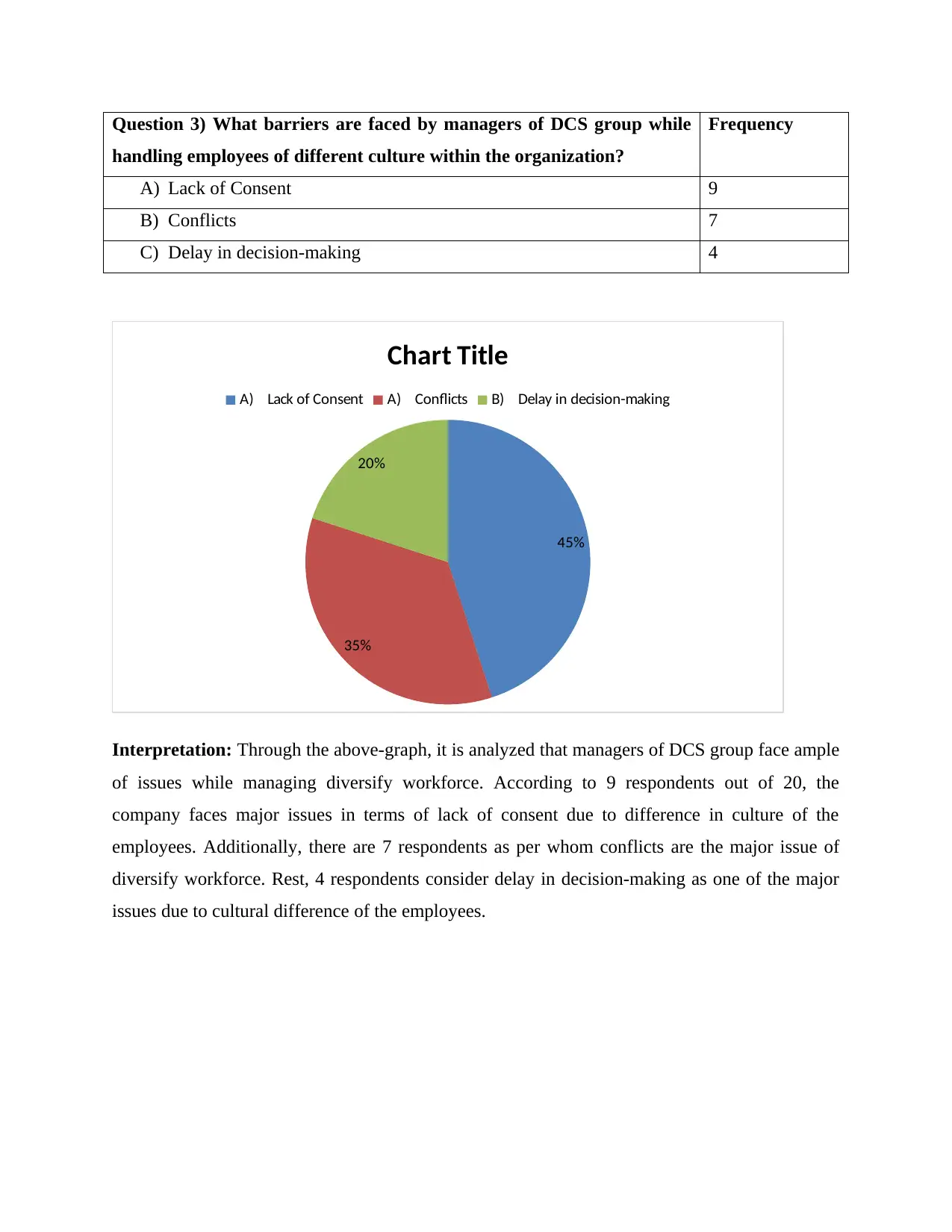
Question 3) What barriers are faced by managers of DCS group while
handling employees of different culture within the organization?
Frequency
A) Lack of Consent 9
B) Conflicts 7
C) Delay in decision-making 4
45%
35%
20%
Chart Title
A) Lack of Consent A) Conflicts B) Delay in decision-making
Interpretation: Through the above-graph, it is analyzed that managers of DCS group face ample
of issues while managing diversify workforce. According to 9 respondents out of 20, the
company faces major issues in terms of lack of consent due to difference in culture of the
employees. Additionally, there are 7 respondents as per whom conflicts are the major issue of
diversify workforce. Rest, 4 respondents consider delay in decision-making as one of the major
issues due to cultural difference of the employees.
handling employees of different culture within the organization?
Frequency
A) Lack of Consent 9
B) Conflicts 7
C) Delay in decision-making 4
45%
35%
20%
Chart Title
A) Lack of Consent A) Conflicts B) Delay in decision-making
Interpretation: Through the above-graph, it is analyzed that managers of DCS group face ample
of issues while managing diversify workforce. According to 9 respondents out of 20, the
company faces major issues in terms of lack of consent due to difference in culture of the
employees. Additionally, there are 7 respondents as per whom conflicts are the major issue of
diversify workforce. Rest, 4 respondents consider delay in decision-making as one of the major
issues due to cultural difference of the employees.
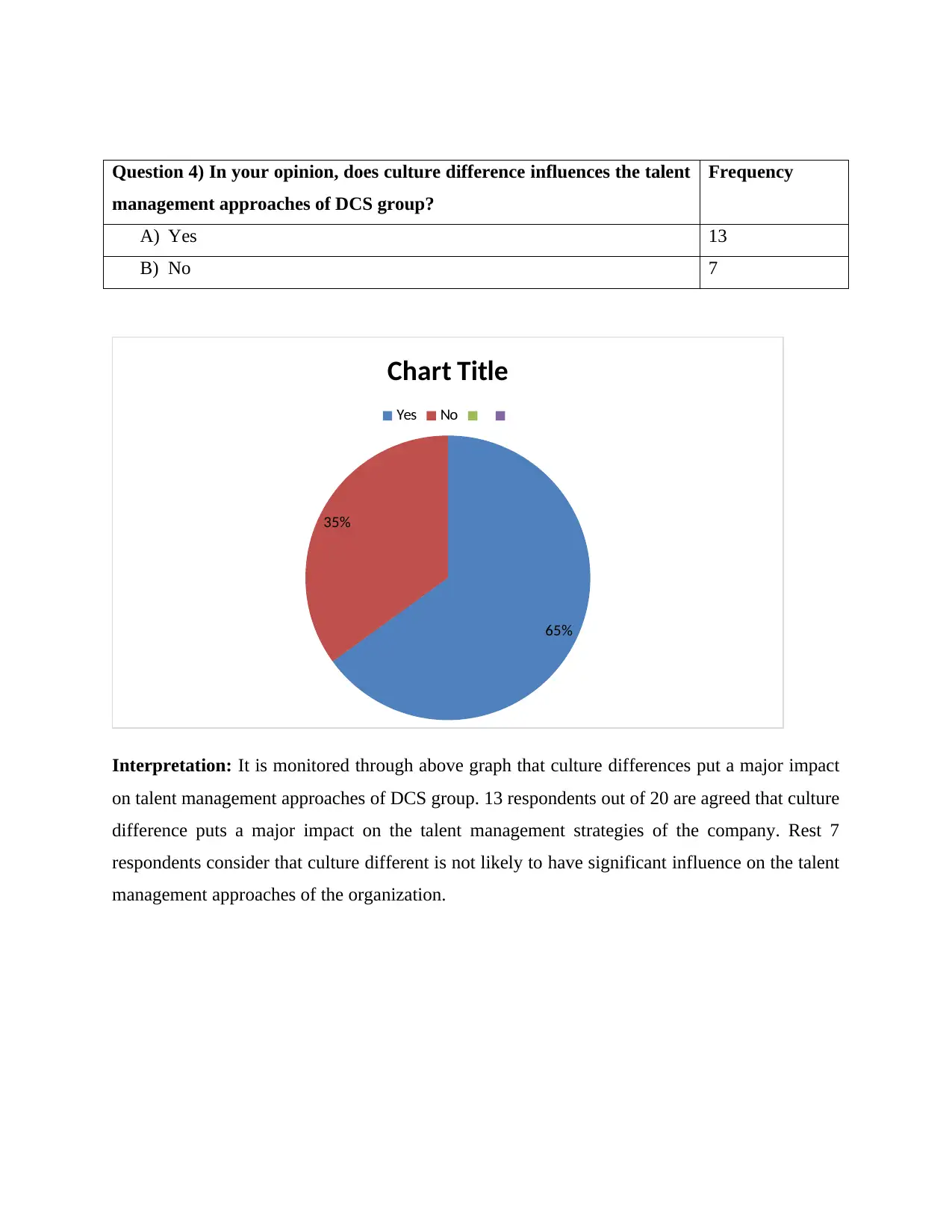
Question 4) In your opinion, does culture difference influences the talent
management approaches of DCS group?
Frequency
A) Yes 13
B) No 7
65%
35%
Chart Title
Yes No
Interpretation: It is monitored through above graph that culture differences put a major impact
on talent management approaches of DCS group. 13 respondents out of 20 are agreed that culture
difference puts a major impact on the talent management strategies of the company. Rest 7
respondents consider that culture different is not likely to have significant influence on the talent
management approaches of the organization.
management approaches of DCS group?
Frequency
A) Yes 13
B) No 7
65%
35%
Chart Title
Yes No
Interpretation: It is monitored through above graph that culture differences put a major impact
on talent management approaches of DCS group. 13 respondents out of 20 are agreed that culture
difference puts a major impact on the talent management strategies of the company. Rest 7
respondents consider that culture different is not likely to have significant influence on the talent
management approaches of the organization.
⊘ This is a preview!⊘
Do you want full access?
Subscribe today to unlock all pages.

Trusted by 1+ million students worldwide
1 out of 22
Related Documents
Your All-in-One AI-Powered Toolkit for Academic Success.
+13062052269
info@desklib.com
Available 24*7 on WhatsApp / Email
![[object Object]](/_next/static/media/star-bottom.7253800d.svg)
Unlock your academic potential
Copyright © 2020–2025 A2Z Services. All Rights Reserved. Developed and managed by ZUCOL.





